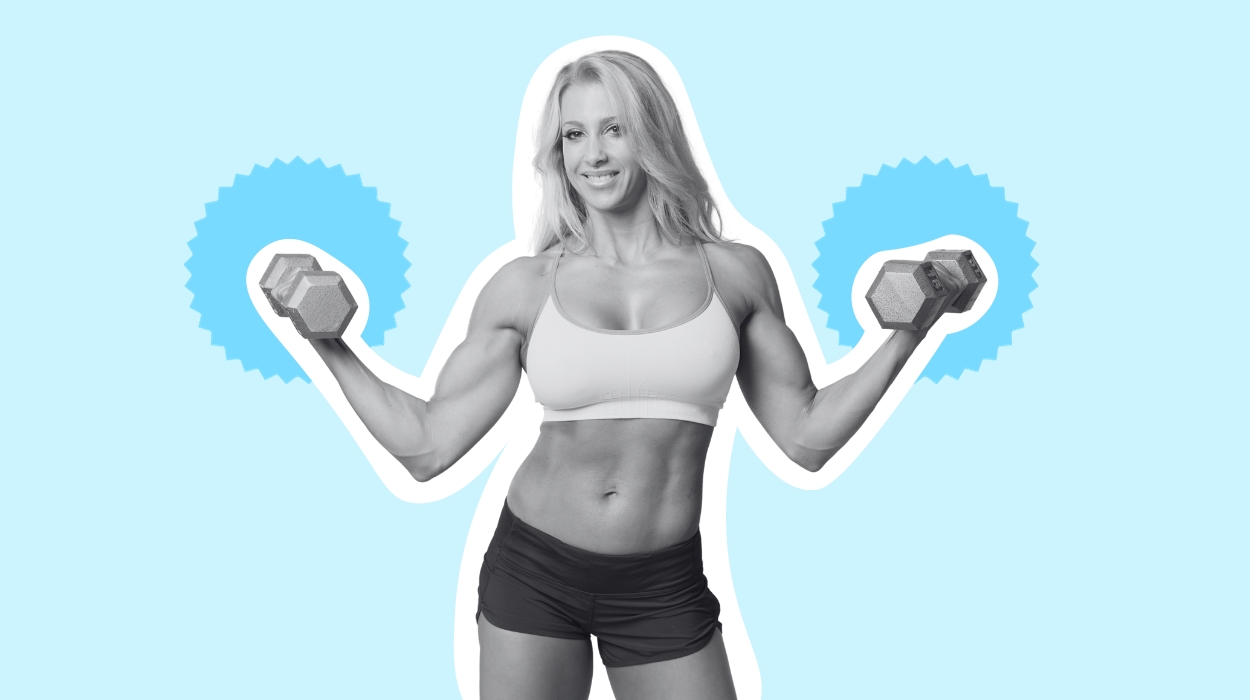Underarm fat is a common frustration for men and women. For some, it can feel physically uncomfortable and for others, it may feel embarrassing. Underarm fat is often a side effect of weight gain, whether from pregnancy or a sedentary lifestyle, and in other cases, underarm fat can develop based on genetic predisposition, hormone fluctuation, or certain illnesses.
This article will discuss some factors that can contribute to underarm fat as well as how to get rid of underarm fat, including detailed exercises that target the arms and chest. After reading this, you’ll have concrete methods to explore that can help you lose arm fat quickly, effectively, and safely.
7 Exercises On How To Remove Breast Side Fat And Underarm Fat
Underarm fat can be the result of poor diet, genetics, and other factors. Although frustrating, you can learn how to get rid of underarm fat quickly and safely by performing these exercises:
- Chair Or Bench Dips.
- Cat-Cow Pose.
- Downward Facing Dog.
- Tricep Presses.
- Push-Ups.
- Chest Presses.
- Bicep Curls.
How To Get Rid Of Underarm Fat Quickly: 7 Best Exercises
Learn how to get rid of underarm fat quickly through targeted arm and chest exercises, which can burn fat while building upper body strength.
Even when armpit fat is not the result of weight gain, but rather, the result of hormone fluctuation or an infection, remember that exercise helps balance hormones[1] and heal the body, so exercise can still help.
Chair Or Bench Dips
The Chair or Bench Dip exercise is a simple yet effective bodyweight movement that targets the triceps, shoulders, and chest muscles. By using a stable surface like a chair or bench, this exercise can be easily incorporated into a home workout routine to strengthen the upper body.
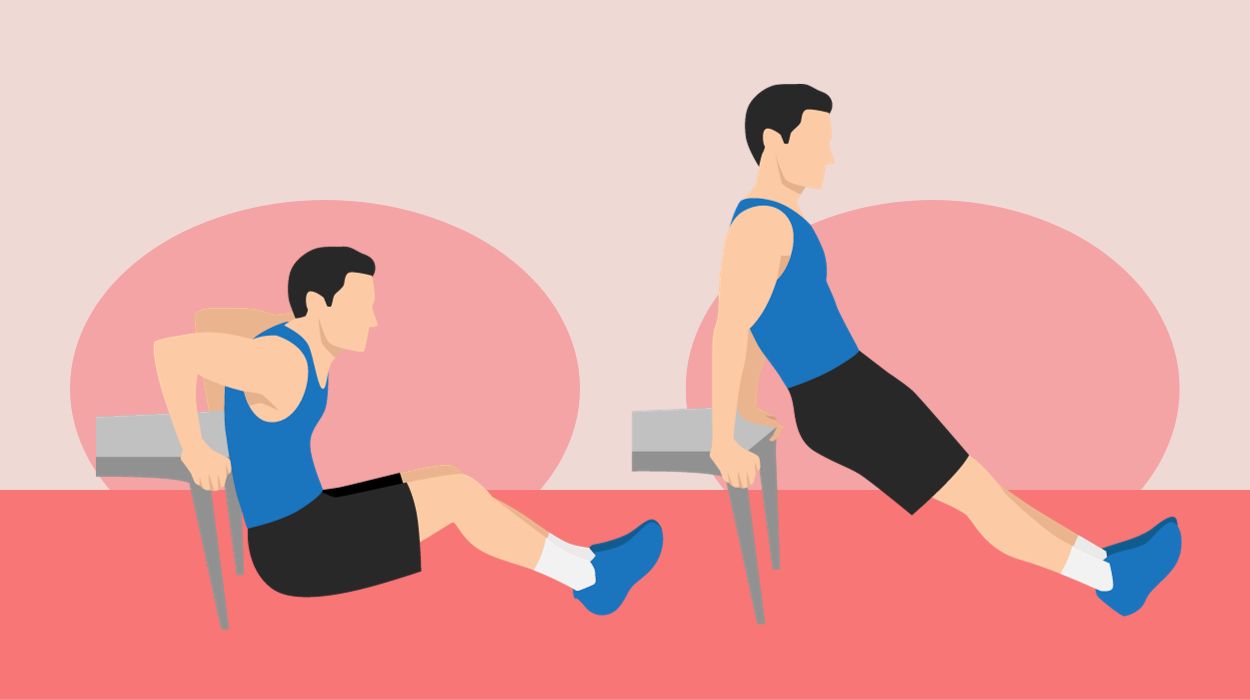
How to do:
- Sit on a chair or bench. With your hands, push yourself up and off the seat, using your outstretched legs to hold up the lower half of your body, while your arms support the rest of your weight. Keep your core tight.
- Bend your elbows to lower yourself toward the floor, then push yourself back up.
- Repeat lowering yourself down and pushing yourself up as many times as you can.
- You can repeat this for eight to ten reps, completing three to four sets.
Tips:
- Keep your shoulders down and away from your ears to prevent unnecessary strain on your shoulder joints.
- Focus on maintaining a stable and controlled motion throughout the exercise, avoiding any sudden or jerky movements.
- If you’re looking for a more advanced variation, you can elevate your feet on another surface or use a weighted backpack or weight belt to increase resistance gradually.
Optimal Sets and Reps: 3 sets of 12-15 reps.
Cat-Cow Pose
The Cat-Cow Pose exercise is a yoga movement that helps improve spinal flexibility and mobility. By alternating between arching and rounding the back, this exercise can alleviate tension in the spine and promote relaxation.
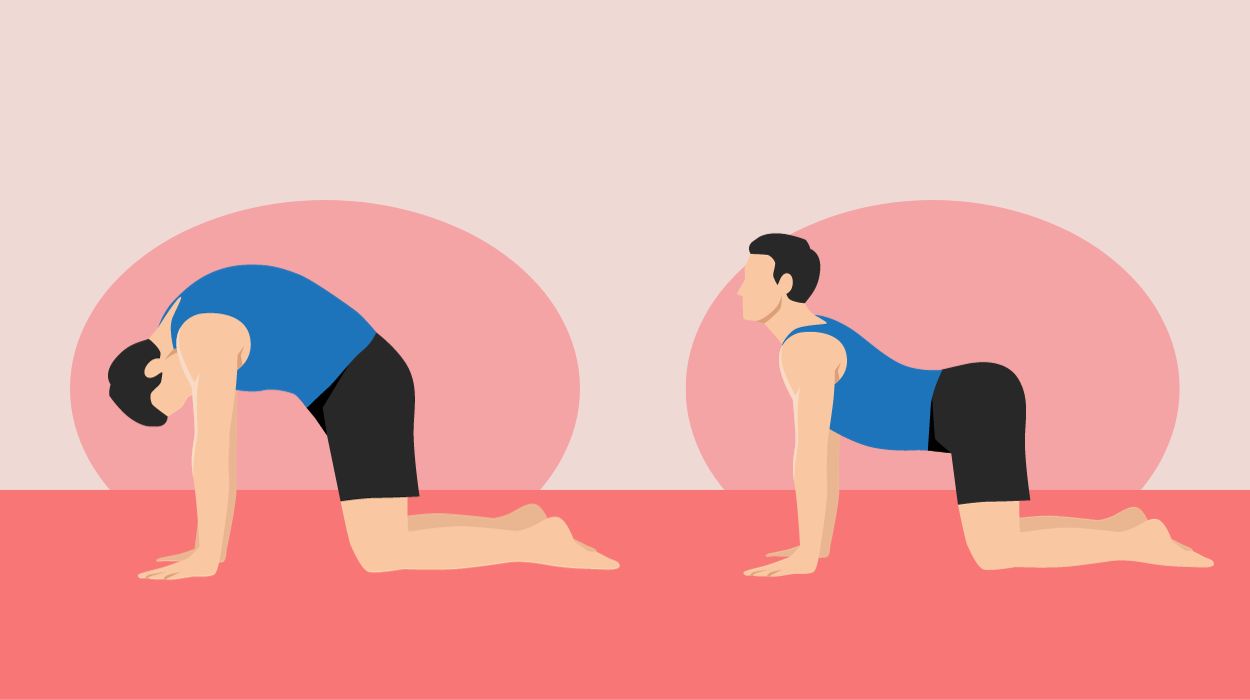
How to do:
- Start in a neutral position on your hands and knees, also known as all fours, keeping your back level and your knees and hands shoulder-width apart.
- Inhale deeply and reach your head and pelvis up toward the ceiling while curving your spine so that your belly goes toward the floor (your upper body should make a “U” shape). This is a “cow” pose.
- Exhale then invert your body into a “cat” pose by bringing your head and pelvis down toward the floor and curving your spine up toward the ceiling (your body should now be making an upside-down “U” shape).
- Alternate between “cat” and “cow” several times, always using your knees for support, and keeping your hands pressed firmly into the floor. Your arms should stay straight the whole time.
Tips:
- Engage your core muscles as you move through the poses to support your spine and enhance stability.
- Focus on the quality of your breath, taking slow and deep inhales during the Cow pose and complete exhales during the Cat pose to promote relaxation.
- Customize the depth of your stretch by adjusting the degree of arch and rounding in your back, catering to your comfort and flexibility.
Optimal Sets and Reps: The Cat-Cow Pose is typically done as a dynamic stretching exercise rather than sets and reps so you can perform it for 5-10 rounds.
Downward Facing Dog
The Downward Facing Dog exercise is a fundamental yoga pose that targets the entire body, including the shoulders, hamstrings, and calves. By assuming an inverted V shape with the body, this pose lengthens the spine, stretches the back muscles, and improves overall flexibility and strength.
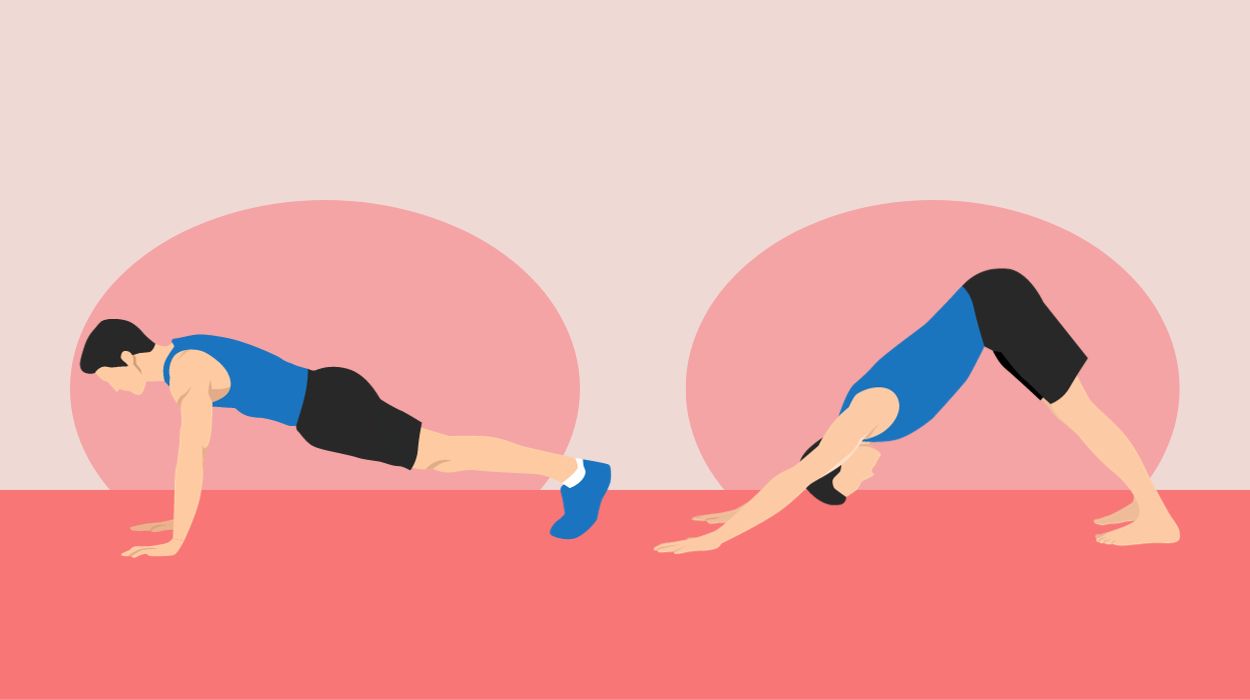
How to do:
- You may start in a plank position or on your hands and knees, whichever is more comfortable.
- From there, push yourself up, pushing your pelvis toward the ceiling, so that you make an upside-down “V” with your body, keeping your feet on the floor behind you. Use your straight, firm arms to support you. Your buttocks should be pointed up creating the point of the “V.”
- Lower your head so that it rests in between your shoulders. Keep pressing your arms and legs to bring your buttocks as high and back as they will go.
- Hold this pose for 30-60 seconds while breathing deeply to better engage your core.[2] Repeat as many times as you can.
Tips:
- Keep your fingers spread wide and distribute your weight evenly through your palms and fingers to maintain stability and prevent wrist discomfort.
- Engage your core muscles by drawing your navel toward your spine to support your lower back and protect it during the pose.
- Press your heels toward the floor, even if they don’t touch, to stretch your calf muscles and promote hamstring flexibility.
Optimal Sets and Reps: Hold the pose for 5-10 breaths and repeat it 3-5 times.
Tricep Presses
Tricep Presses are a strength training exercise that primarily targets the triceps muscles. By extending the arms overhead and lowering a weight behind the head, this exercise effectively strengthens and tones the back of the arms.
How to do:
- Lie down on an exercise bench, plant your feet firmly on the ground, and hold a dumbbell in each hand.
- Extend the dumbbells up and turn your arms in a little so that your palms are facing you.
- Lower your elbows to bring the dumbbells down toward your body, keeping your elbows close to your body. Breathe in.
- On the exhale, press the dumbbells straight up.
- Repeat as many times as you are able, rest for a few minutes, then do two more sets.
Tips:
- Keep your elbows close to your head throughout the exercise to isolate the triceps and prevent unnecessary strain on your shoulders.
- Control the movement by lowering and lifting the weight or resistance band in a slow and controlled manner to maximize muscle engagement.
- Ensure you fully extend your arms at the top of the movement to achieve a complete contraction of the triceps.
Optimal Sets and Reps: 3 sets of 12-15 reps.
Push-Ups
Push-Ups are a classic bodyweight exercise that targets multiple muscle groups, including the chest, shoulders, and triceps. By lowering and raising the body using arm strength, this exercise helps build upper body strength and endurance.
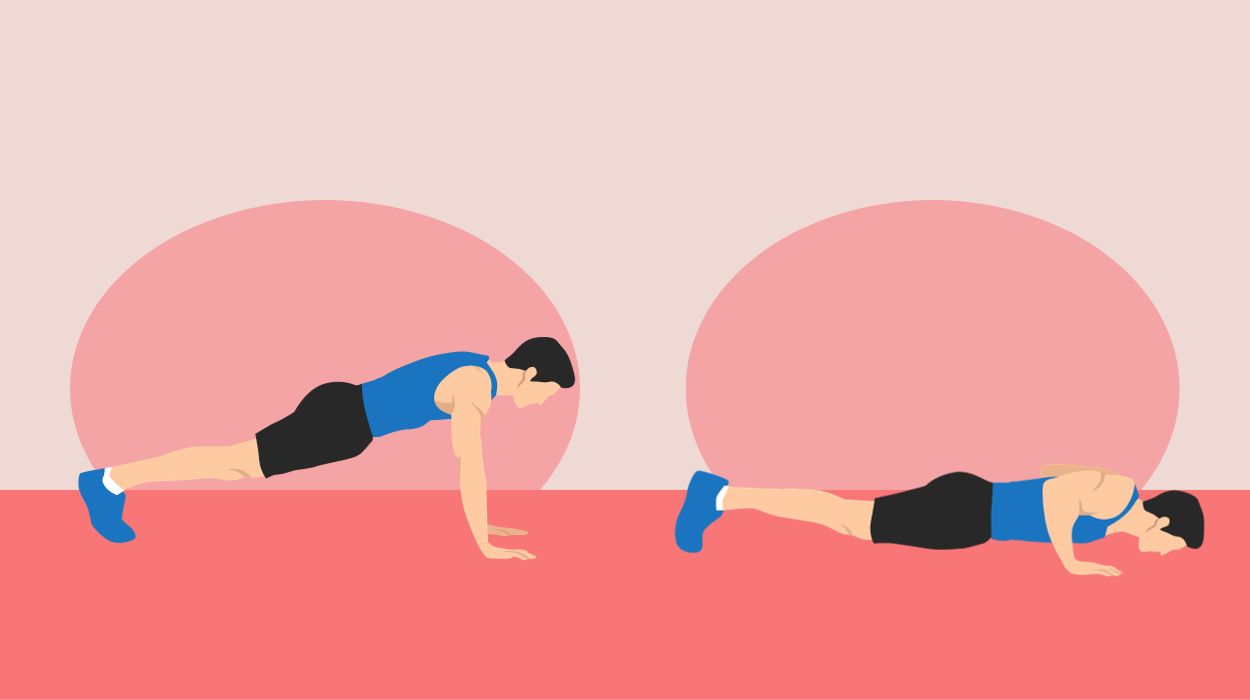
How to do:
- Start in a plank position, with straight arms and legs supporting your body above the ground. Keep your head straight and your body tight.
- With your elbows only, lower your body down to the floor, then push yourself back up. Keep your body stiff and straight.
- Repeat. Keep lowering and lifting your body as many times as you can.
- Complete two more sets of pushups,[3] taking a break between each set.
Tips:
- Maintain proper alignment by keeping your head in a neutral position, and avoiding looking up or down during the exercise.
- Engage your core muscles throughout the entire range of motion to stabilize your body and protect your lower back.
- Focus on your breathing, exhaling as you push yourself up and inhaling as you lower your chest toward the ground to maintain a steady rhythm.
Optimal Sets and Reps: 3 sets of 10-15 reps.
Chest Presses
The Chest Presses exercise is a fundamental strength training movement that targets the chest muscles, specifically the pectoralis major and minor. By pushing weights away from the body while lying on a bench or stability ball, this exercise helps build upper body strength and muscle mass in the chest region.
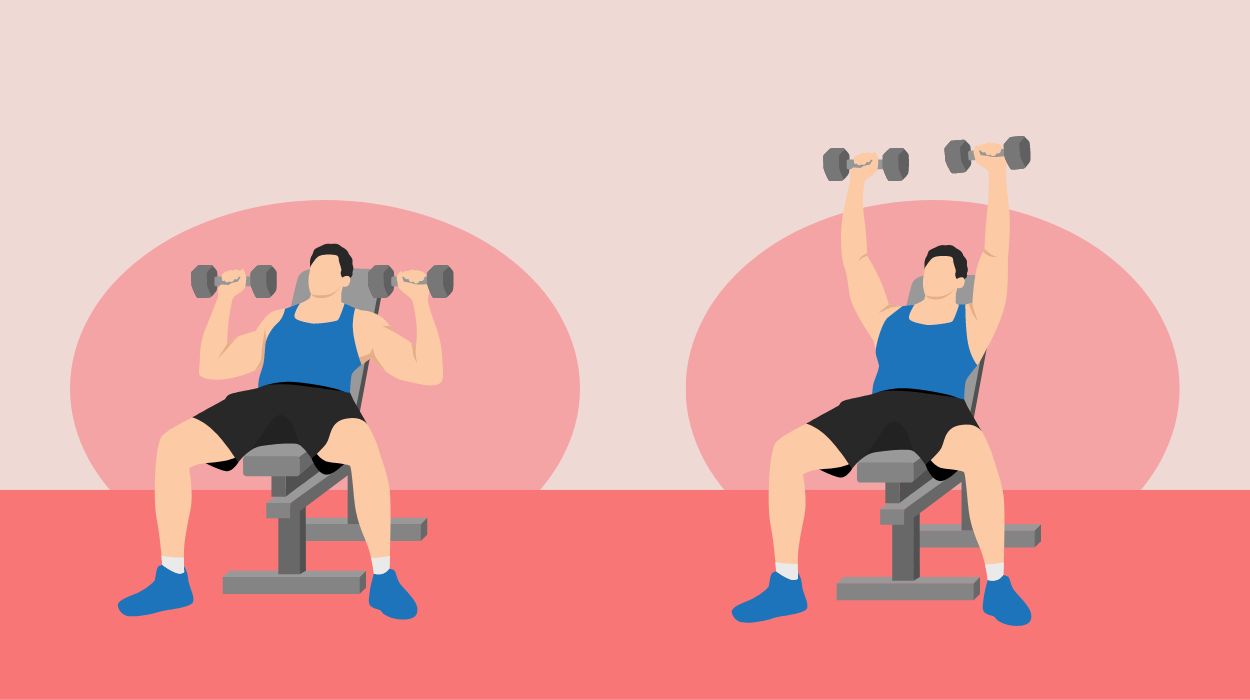
How to do:
- Using a workout bench, take a dumbbell in each hand and lie on your back.
- Plant your feet firmly on the ground and lift the dumbbells over your head.
- Bending your elbows, lower the dumbbells down to your chest so that your arms are making a 90-degree angle. Be sure not to lower the dumbbells down your shoulders, but rather, so that they come down over your chest/breasts.
- Exhale and push the dumbbells straight up. Hold them there for a few seconds, then lower them back down to your chest/breasts.
- Repeat for eight to ten reps, rest, then do two more sets.
Tips:
- Keep your shoulder blades squeezed together and your chest puffed out to maintain stability and ensure proper form during the exercise.
- Focus on your breathing, exhaling as you push the weights up and inhaling as you lower them down to maintain a consistent rhythm.
- Gradually increase the weight as you progress to continue challenging your chest muscles and promoting strength and growth.
Optimal Sets and Reps: 3 sets of 8-12 reps.
Bicep Curls
The Bicep Curls exercise is a popular strength training movement that targets the biceps brachii muscles. By curling weights towards the shoulders while keeping the elbows stable, this exercise effectively strengthens and tones the muscles in the front of the upper arms.
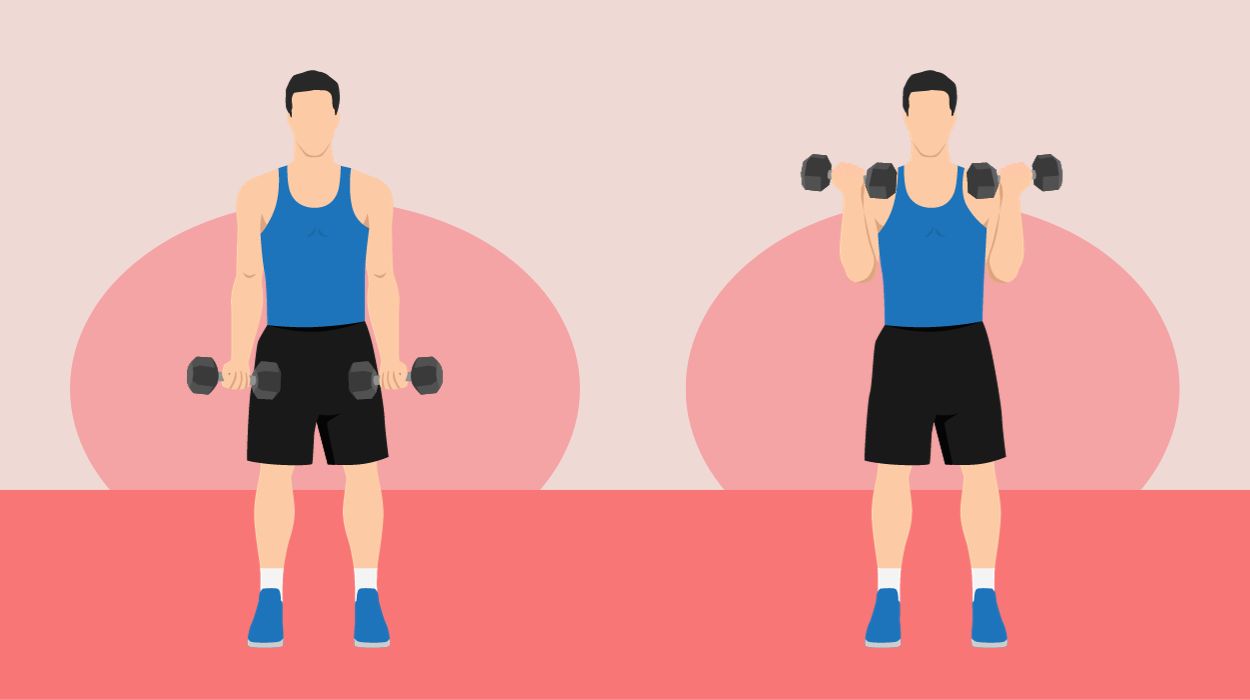
How to do:
- Stand up straight, holding a dumbbell in each hand by your sides, with your palms facing upward.
- Bend your elbow to curl the weight up to elbow height. Keep your elbows tucked close to your body.
- Lower the weight back down to your side.
- You can do this one arm at a time, or both arms at once. Repeat bicep curls as many times as you are comfortable, then rest and repeat the set.
Tips:
- Keep your wrists in a neutral position, avoiding excessive bending, to reduce strain on your wrist joints and maintain proper form.
- Avoid using momentum by lifting the weight slowly and under control throughout the entire range of motion.
- Focus on squeezing and contracting your biceps at the top of each repetition to maximize muscle engagement.
Optimal Sets and Reps: 3 sets of 10-12 reps.
Armpit Fat Causes
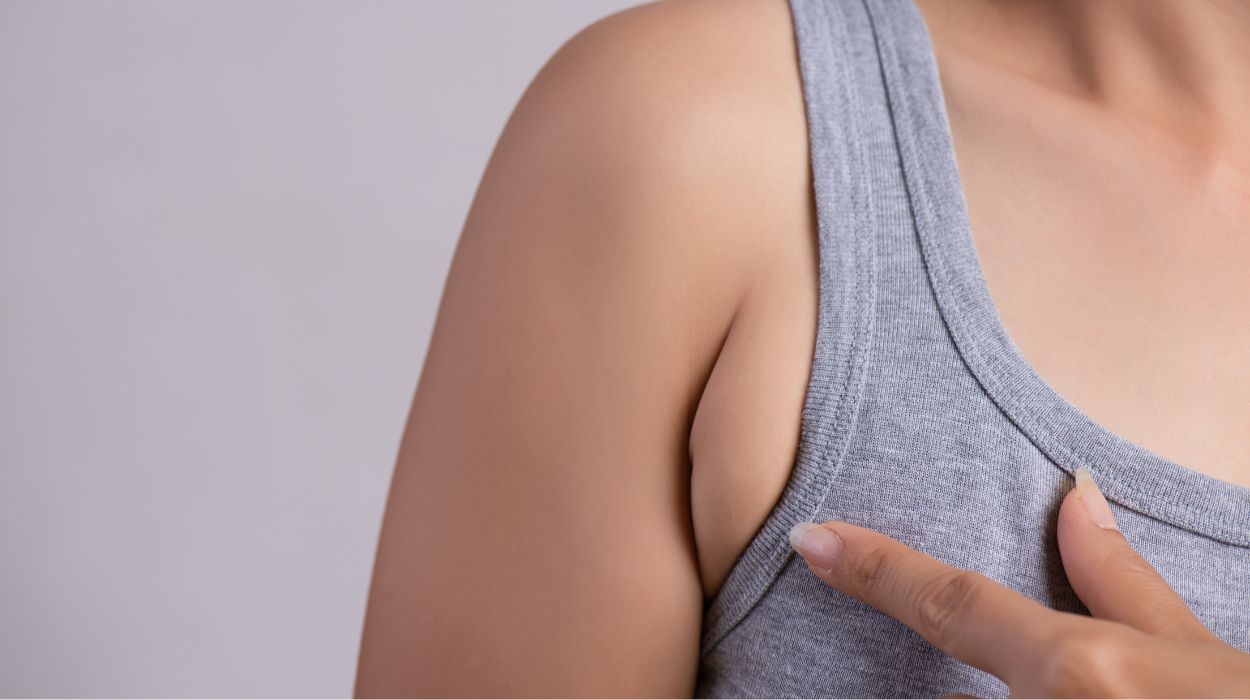
Genetics
Some people may be genetically predisposed to underarm fat, as genetics play a role in where a person may be more prone to accumulate fat. That being said, epigenetics,[4] the science of how our environment influences our genes, suggests that genetics alone may not be a guarantee of developing underarm fat–lifestyle plays a role.
Poor Diet And Lack Of Exercise
More specifically, an unhealthy diet, consisting of mostly processed, fried, and refined foods, as well as excess sugar and salt, can contribute to fat cells developing anywhere in the body. Additionally, a sedentary lifestyle, in which a person engages in little-to-no physical activity can create fertile ground for fat to develop and stay stuck in the body.
Illness Or Injury
In some instances, armpit fat may be caused by lymphedema,[5] or swollen lymph nodes. Incurring an infection or arm injury, as well as having lymphoma or breast cancer, may cause the lymph nodes in the armpit to swell, giving the appearance of underarm fat.
Hormones
Hormonal changes from puberty, pregnancy, and menopause may also be responsible for underarm fat. During these stages of a woman’s life, hormones[6] such as FSH (follicle-stimulating hormone), estrogen, and progesterone levels can fluctuate, which can cause breast swelling and excess underarm fat.
As the breastfeeding hormone, prolactin,[7] increases for new mothers, breasts can grow bigger and create more fat in the area.
Axillary Breast Tissue
Some people have axillary breast tissue,[8] or excess breast tissue which grows outside of the breast area. Though it is rare to develop axillary breast tissue, it can happen in both women and men. The tissue, similar to breast tissue, is susceptible to enlargement[9] as hormone levels throughout the body change.
Other Tips On How To Get Rid Of Armpit Fat
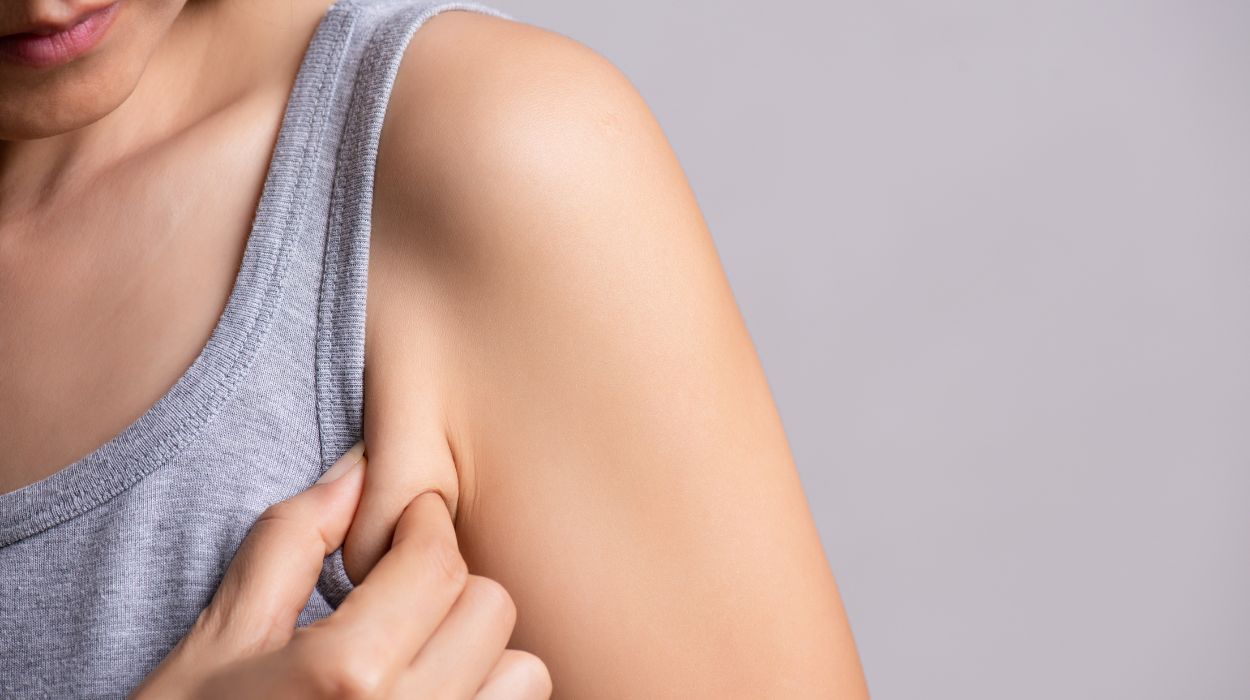
Losing underarm fat, like any fat-loss process, can take some time. However, these tips combined will teach you how to get rid of underarm fat quickly.
Watch Your Diet
No fat loss plan will succeed if you are eating a diet high in calories, processed foods, and sugar. A healthy, whole foods-based, nutrient-dense diet must be at the core of your weight loss plan.
Making your diet more healthy can include adding more protein and fewer carbs, or eating more vegetables and less high-sugar fruit–these nuances will depend on the individual, however, the baseline eating approach for overall body fat loss should be less packaged and processed foods[10] and more whole foods.
Get Quality Sleep
Sleep is an underestimated power player in weight management. Consistent quality sleep helps hormones that regulate metabolism and appetite function optimally, whereas sleep deprivation[11] has been linked to weight gain and difficulty losing body weight.
Low energy and fatigue from sleep loss can also enhance food cravings, particularly cravings for carbohydrates, to give us a quick boost of energy.
Reduce Stress
Stress is a silent but powerful contributor to weight gain. When under stress, excess cortisol, the stress hormone, circulates throughout the body. This can interfere with many other hormone functions leading to the accumulation of fat. While excess fat from stress often builds up around the midsection, stress can make weight loss in any part of the body more difficult.
Exercise
If you want to see weight loss results, you must have exercise in your routine. While many specific exercises target underarm fat, losing overall fat and increasing fitness will assist in lowering body fat, including armpit fat. Consider doing cardio or any form of exercise a few times a week to see quicker results.
Focus On Arms And Chest
In addition to cardio exercises, to reduce both upper arm fat and underarm fat, you will need to focus your attention on the arm and chest muscles. Exercises that target the arms and chest include bench presses, push-ups, arm circles, planks, superman poses, and bicep curls. Yoga poses may also be beneficial for enhancing and toning the chest and arms, thereby reducing underarm fat.
Hydrate
Water is crucial to life, even when not undergoing weight loss efforts. However, when attempting to lose underarm fat, hydration[12] is that much more essential. Water not only replenishes hydration lost during workouts, which should be done regularly to reduce underarm fat, but it also helps to curb appetite, decreasing the likelihood of snacking.
When setting off to lose underarm fat, be sure to add hydration to your regime. How much water you should drink to lose weight will vary slightly from person to person, however, it’s recommended for most people to drink between 8-10 glasses of water a day.
How Long Does It Take To Get Rid Of Underarm Fat?
Now that you know what causes underarm fat and how to get rid of it, the question remains: how long does it take to get rid of underarm fat? It will take anywhere from three to six months to see results.
Unlike the arms, legs, and back which are very muscular, the underarms do not naturally contain a lot of muscle. This makes the area more difficult to exercise and to replace fat with muscle. This just means you may not see results overnight, but if you continue with an exercise regime, healthy diet, and other healthy lifestyle modifications, results, including weight loss, will come faster.
Conclusion
Underarm fat can be frustrating to deal with. Some individuals are more prone to developing underarm fat due to their genetics, however, many other factors can contribute to underarm fat, such as weight gain from a poor diet and a sedentary lifestyle, pregnancy, improper hydration, poor sleep, infections, and hormone imbalances.
Changing your diet and focusing your exercise routine to target your arms and chest are the best ways to start reducing underarm fat. Additionally, managing stress, getting better sleep, and hydrating properly can assist the fat loss process, helping you achieve results sooner.
Frequently Asked Questions
Not necessarily. Underarm fat is often the result of weight gain. Once overall weight loss is achieved, fat from the underarm area will usually reduce. However, it can take longer to lose fat in the underarm area compared with other areas of the body.
No. With adjustments to diet and exercise routine, and when hormones are balanced, underarm fat can be reduced.
Armpit fat should look like a small bulge of fat under the arms, separate from the arms and breasts.
Genetics could be one reason why you develop more fat under your left arm than your right, as genetics play a role in where fat gets stored, and you may be predisposed to one area or side of your body for fat storage. However, genetics are only one possible contributor to fat development and storage.
It should not. If you are wearing tight clothing that is pinching or restricting the fat, then this might cause pain or discomfort, but otherwise, armpit fat should not hurt. If it does, alert your doctor.
 Expert's opinion
Expert's opinion